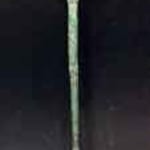Luristan Bronze Openwork Pin, 1000 BCE - 650 BCE
Copper Alloy
7
LO.1045
Further images
Numerous are the pins found in the Luristan cultural sphere, the most important site being the Surkh Dum shrine. In its temples pins were deposited in large numbers. They also...
Numerous are the pins found in the Luristan cultural sphere, the most important site being the Surkh Dum shrine. In its temples pins were deposited in large numbers. They also appear regularly in burial contexts, but occasionally in settlements, suggesting a dominant ceremonial connotation. Yet simple straight garment pins with plan upper shanks were indeed used in the area from the 3rd millennium BC onwards until they were superseded in the 8th century BC, when the fibula, or safety pin, replaced them.
In the late Bronze Age and early Iron age period they became much more ornate and increasingly decorated with animal or floral shaped heads. Although some of these pins could be light enough to be worn as dress pins, many are much too large and heavy for a mundane function and possibly had a ritual connotation, such as those found in the already cited Surkh Dum shrine, which were built into the stone walls and served as religious symbols or icons.
In the case of the pin illustrated above, the dynamic composition in openwork within a closed circular frame showing three animal protomes radiating from the centre would be stylistically consistent with the Iron Age production in Luristan, when similar pinheads were profusely created. The theme of animals radiating, mostly showing only the protome or the head of the zoomorphs, (by some scholars associated with the sun) was incredibly popular during the late Bronze Age period throughout Central Asia. Similar compositions eventually reached China during the mid 1st millennium BC, through the influence of nomadic iconography. Indeed it is only recently that archaeological evidence has helped in determining the predominant osmotic role of nomadic people (such as the Andronovo) in the transmission of ideas and iconographies between the BMAC (Bactria and Margiana) and China during the Bronze Age Period.
References:
Houshang Mahboubian, The Art of Ancient Iran, 1998 and Los Angeles County Museum, Ancient Bronzes, Ceramics and Seals, 1981: pp.73-74.
In the late Bronze Age and early Iron age period they became much more ornate and increasingly decorated with animal or floral shaped heads. Although some of these pins could be light enough to be worn as dress pins, many are much too large and heavy for a mundane function and possibly had a ritual connotation, such as those found in the already cited Surkh Dum shrine, which were built into the stone walls and served as religious symbols or icons.
In the case of the pin illustrated above, the dynamic composition in openwork within a closed circular frame showing three animal protomes radiating from the centre would be stylistically consistent with the Iron Age production in Luristan, when similar pinheads were profusely created. The theme of animals radiating, mostly showing only the protome or the head of the zoomorphs, (by some scholars associated with the sun) was incredibly popular during the late Bronze Age period throughout Central Asia. Similar compositions eventually reached China during the mid 1st millennium BC, through the influence of nomadic iconography. Indeed it is only recently that archaeological evidence has helped in determining the predominant osmotic role of nomadic people (such as the Andronovo) in the transmission of ideas and iconographies between the BMAC (Bactria and Margiana) and China during the Bronze Age Period.
References:
Houshang Mahboubian, The Art of Ancient Iran, 1998 and Los Angeles County Museum, Ancient Bronzes, Ceramics and Seals, 1981: pp.73-74.





